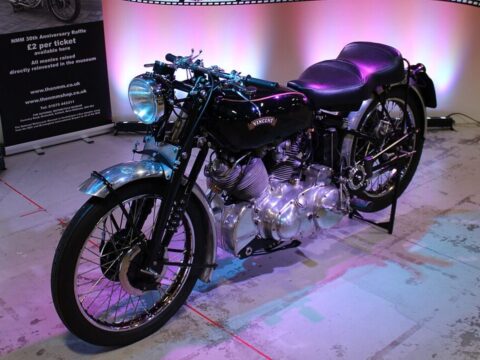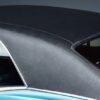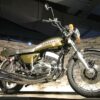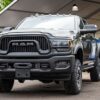For decades, 2-stroke motorcycles have been known for their unique power, lightweight design, and unmistakable sound. These bikes have left a lasting mark on both racing and everyday riding, delivering thrilling performance and unforgettable experiences. From track legends to street favorites, here are 12 iconic 2-stroke motorcycles that have revved their way into history.
Contents
Yamaha RD350

The Yamaha RD350, first released in 1973, quickly gained a reputation for its exceptional power-to-weight ratio. Featuring a 347cc engine, it produced an impressive 39 horsepower, which made it one of the fastest machines in its class. Riders appreciated its nimble handling and raw, responsive engine, perfect for street riding and amateur racing. As a result, the RD350 has become a symbol of Yamaha’s dominance in the 2-stroke market, remembered fondly for its thrilling performance. This motorcycle still enjoys a strong following among collectors and enthusiasts.
Suzuki GT750

Launched in 1971, the Suzuki GT750 was the first mass-produced motorcycle with a water-cooled 2-stroke engine, earning it the nickname “Water Buffalo.” Its 739cc triple-cylinder engine offered smooth, reliable power, which made it a favorite among long-distance touring riders. Despite its somewhat heavy frame, the GT750 was known for being easy to ride, combining comfort with performance. Its innovation with water cooling was a game-changer for 2-stroke motorcycles at the time.
Kawasaki H2 Mach IV

The Kawasaki H2 Mach IV, introduced in 1972, became legendary for its astonishing 748cc engine, producing 74 horsepower, a groundbreaking figure for its time. Known for its explosive acceleration, the H2 could reach 120 mph, making it one of the fastest bikes on the road. However, its lightweight frame paired with such immense power gave it unpredictable handling, earning the bike a wild reputation. The H2 Mach IV remains a cult classic, revered for its untamed spirit.
Yamaha TZ750

Built exclusively for racing, the Yamaha TZ750 stormed onto the circuit in the 1970s, redefining motorcycle performance. Its 694cc 2-stroke engine was capable of producing 120 horsepower, which pushed the boundaries of speed for bikes of its era. Many professional riders found its power almost too much to handle, yet it dominated races, leading to adjustments in some competitions to balance its overwhelming performance. The TZ750 was a staple in the racing world, known for its aggressive power delivery and unmatched speed.
Suzuki RG500 Gamma

Inspired by Suzuki’s Grand Prix racing success, the RG500 Gamma debuted in 1985, featuring a 498cc square-four engine. It offered the high-revving performance of a race bike with the accessibility of a road-going motorcycle. Riders praised the RG500 for its lightweight frame and outstanding handling, allowing it to compete with larger, more powerful bikes. With 94 horsepower at its disposal, the RG500 was a formidable presence on both the track and the street.
Aprilia RS250

The Aprilia RS250, introduced in 1995, captured the hearts of track enthusiasts with its sleek, race-inspired design and sharp handling. Powered by a 249cc 2-stroke engine derived from Suzuki’s RGV250, the RS250 produced 60 horsepower, which was plenty for its lightweight frame. Aprilia built the RS250 to emulate the feel of a Grand Prix bike, with a focus on precision and control. The RS250 is remembered as one of the best-handling 2-stroke bikes ever made.
Honda NSR500

Honda’s NSR500 made waves in the Grand Prix racing scene during the 1980s and 1990s, dominating the competition with its cutting-edge 499cc V4 engine. This beast of a machine could produce over 180 horsepower, making it one of the most powerful 2-strokes ever built. Under the guidance of legendary riders like Mick Doohan, the NSR500 secured numerous world championships. The bike’s precise handling, combined with its immense speed, set new standards for racing motorcycles.
Kawasaki H1 Mach III

Released in 1969, the Kawasaki H1 Mach III made an indelible mark on the motorcycle world with its 500cc 3-cylinder engine, delivering an astonishing 60 horsepower. Its top speed of 115 mph made it one of the fastest production bikes of its time, though its handling could be a challenge. The H1’s explosive acceleration earned it a reputation for being as dangerous as it was exhilarating, with some riders referring to it as a “widow maker.” Nonetheless, the H1 broke new ground in performance, setting a high bar for subsequent models.
Yamaha DT175

Introduced in 1968, the Yamaha DT175 became one of the earliest dual-sport motorcycles, bridging the gap between off-road performance and everyday street riding. Powered by a 171cc 2-stroke engine, the DT175 was lightweight, reliable, and easy to maintain, making it a favorite among adventure riders. Its versatility allowed riders to explore rugged terrain while remaining comfortable on urban roads. This blend of practicality and fun helped make the DT175 a global hit, especially in developing markets.
Honda CR500

The Honda CR500, introduced in 1984, is legendary for its brute force, with a 491cc 2-stroke engine that produced massive torque. Designed for motocross, this bike was capable of breathtaking acceleration, but it also required a skilled hand to manage its power. Known for being difficult to tame, the CR500 nonetheless became a favorite among adrenaline junkies who craved extreme performance. Despite its challenging nature, the CR500 remains a symbol of raw, unfiltered motocross power.
Jawa 350

The Jawa 350, a Czech-built 2-stroke motorcycle, rose to prominence in the 1950s and 1960s due to its simple yet robust design. Featuring a 344cc engine, it became particularly popular in Eastern Europe, where durability and ease of maintenance were key considerations. The Jawa 350’s reputation for reliability made it a favorite for both civilian and military use. Its long production run speaks to its enduring appeal as a functional, no-nonsense motorcycle.
Derbi GPR 50

Derbi’s GPR 50, introduced in the 1990s, was a small but mighty 50cc 2-stroke bike that provided young riders with a taste of the racing world. Styled like a full-sized sportbike, it featured sharp handling and a peppy engine, making it a fun and accessible entry-level machine. The GPR 50 became popular in Europe, particularly among beginners who wanted to experience the thrill of a race-inspired motorcycle without needing a large engine. It was an important model for Derbi, helping the brand carve out a niche in the small-displacement market.
This article originally appeared in MyCarMakesNoise.
More from MyCarMakesNoise
15 Electric Vehicle Add-Ons That Aren’t Worth the Investment

When it comes to electric vehicles (EVs), there are countless add-ons and upgrades available, but not all of them are worth the price. Some can be flashy or tempting, but offer little value for the average driver. Read More.
10 Failed Innovations in Automotive Technology

Innovation drives the automotive industry, pushing the boundaries of what cars can do and how they impact our lives. Over the decades, countless new technologies and ideas have emerged, aiming to revolutionize the way we drive and interact with our vehicles. Read More.
15 Least Fuel-Efficient Cars Ever Produced

Certain automobiles are renowned for prioritizing raw power and luxury over fuel efficiency. Equipped with massive engines and designed for high performance or ultimate comfort, these vehicles exemplify significantly higher fuel consumption. Read More.














